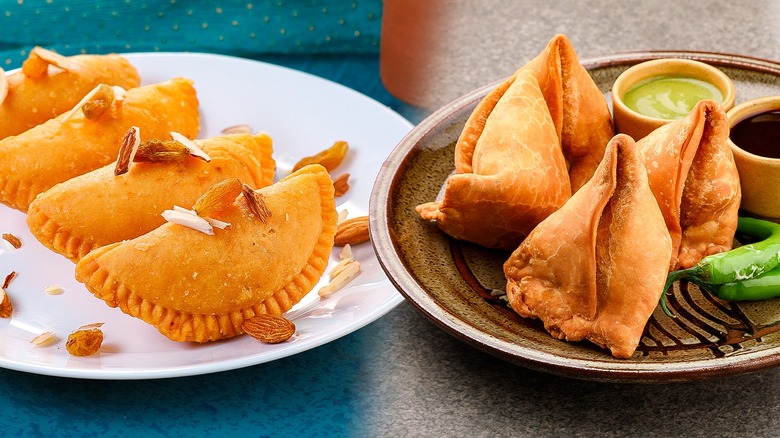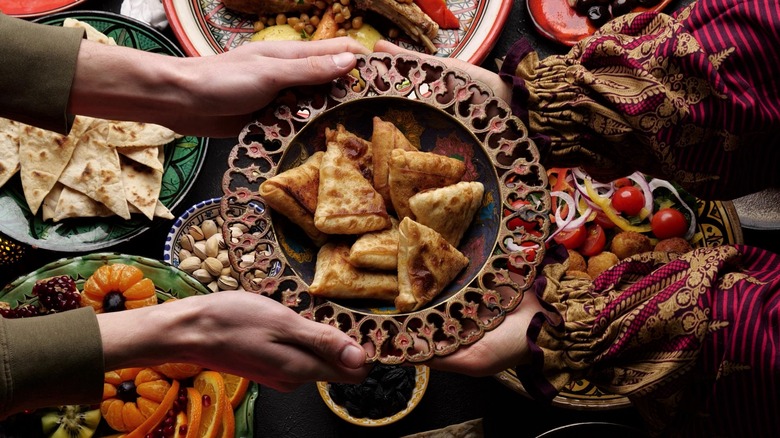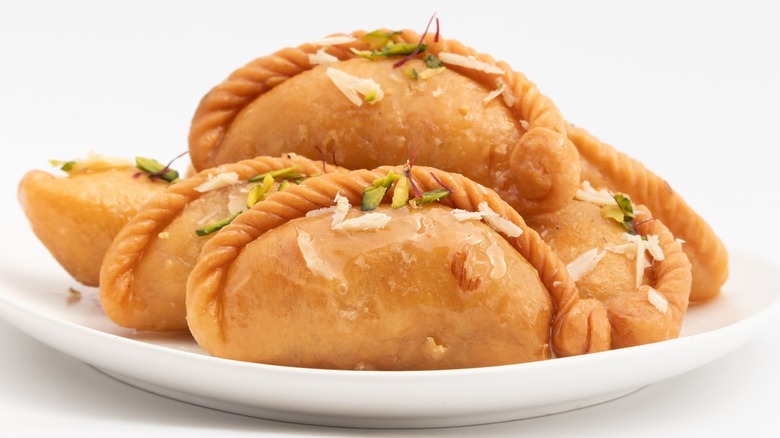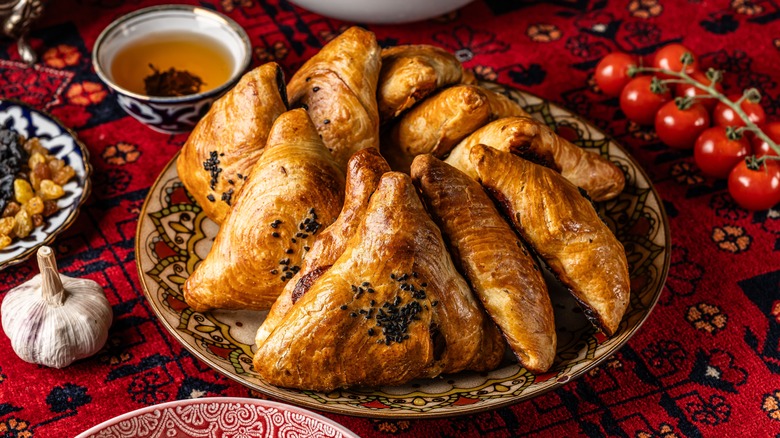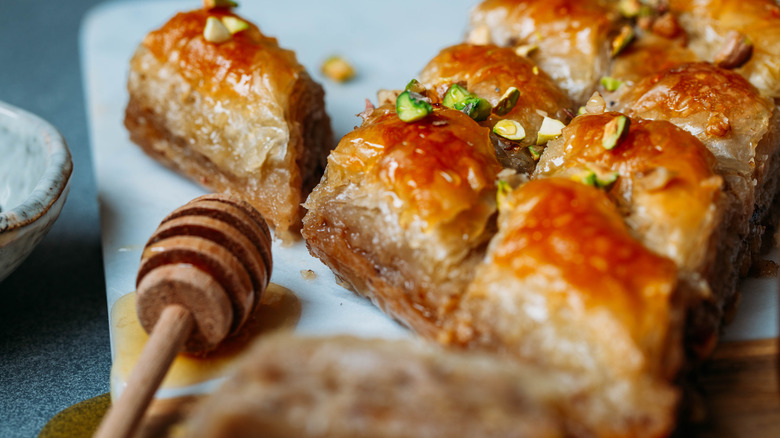Samosas Vs Gujiya: Is There A Difference Between The 2 Holi Treats?
Like so many other holidays, Holi, the Hindu celebration of spring, colors, light, and the love of deities Radha and Krishna, is closely associated with food. In addition to spirited festivities that feature dancing, throwing colored dye powder, and other highlights, those who observe the holiday look forward to a range of Holi treats.
There's the milk and spice beverage thandai, the curd and chutney dish dahi bhalle, and the creamy, almondy badam phirni, but no Holi would be complete without the fried pastries known as gujiya. Though they resemble another fried pastry that is popular in Indian cuisine and eaten around Holi, samosas, gujiya is a distinctly delicious food that deserves due respect.
For those who have ever had Indian cuisine in the U.S., samosas are doubtless familiar. These pockets of fried dough can contain any number of ingredients, from ground, spiced lamb to potatoes and peas, and are generally served with piquant chutneys. Gujiya are also pockets of fried dough, but the fillings they feature typically skew more to the sweet side, with khoya or milk solids, cashews and other nuts, powdered sugar, and coconut being the most common. With so many tasty things to eat around Holi, it's understandable that these items may get mixed up, especially by those unfamiliar, but their unique distinctions make them worthy of more in-depth exploration.
What is a samosa?
Who doesn't love a fried dough pocket full of flavorful fillings? From empanadas to Natchitoches meat pies, there's a satisfying decadence to crispy pastry bathed in hot oil yielding to a sumptuous interior. Samosas are little tetrahedrons of savory, fried delight. Completely wrapped in a thick yet tender and flaky pastry, these dumplings can hold any of a number of fillings, but perhaps the combination most people are familiar with is potato and pea. While this might seem a bit mild by the standards of Indian cuisine, the filling is hearty yet demures to the rich crust.
It also serves as the perfect foil for the array of chutneys and sauces that accompany samosas. Those can include a cool, creamy, and herbaceous raita, vibrant coriander chutney, and sweet, tangy mango chutney. Tart and spicy lime pickles can also dress a samosa, serving as a welcome balance to the incumbent richness.
But, samosas are no monolith. Variations abound across the Indian subcontinent and beyond. Paneer samosas are stuffed with the mild, firm cheese and a bit of onion for a creamier filling, while meat samosas often contain mutton or lamb along with aromatic spices. In other countries, items like Burmese samuza are clear culinary cousins to the samosa. There are even sweet versions, like the khoya samosa, a dumpling stuffed with sweetened milk solids, not unlike a gujiya.
What is a gujiya?
If you've had your fill of savory flavors or just have a sweet tooth that must be satisfied, then put down the samosa and pick up a gujiya. When it comes to these Holi favorites, the order of the day is dessert. The festival itself is a jubilant celebration of light, color, love, and spring, so it should come as no surprise that rib-sticking flavors just aren't where it's at. Sweetness is a common theme you'll find among many traditional Holi foods, and gujiya are no exception.
Shaped in a half-moon fold, a bit like an empanada, gujiyas feature a flaky crust wrapped around a thick, rich, sweet filling. India is, of course, a mammoth nation with many regional cuisines and, as such, there are a plethora of variations on gujiya. The through line is coconut in the filling, but some regions, such as around Goa, use the Indian unrefined sugar jaggery inside, while others, like Gujarat, have nuts and semolina in the filling. Regardless of the differences, these flaky pastries are always sweet.
Samosas may hail from the Middle East
While samosas are undoubtedly associated with modern Indian cuisine, the lineage of the dish may well lie beyond the subcontinent. The word itself seems to be derived from the Persian "sanbosag" which is also referred to in Arab writings of the early 2nd millennium as "sansubak." As the regions we today call the Middle East, Central Asia, and Northern India were linked on vast trade networks, people, ideas, languages, customs, and foods moved freely between them. Variations on the name and dish — which was a convenient food for travelers to carry — are found in accounts of these areas.
It is theorized that samosas moved into India during the time of Muslim rule in the Delhi region. With copious cultural influence flowing from the Arab world, cooks and their skills were welcomed into the homes and kitchens of the elite. Sansubak was introduced, which contained meat, ghee, onions, peas, potatoes, and other ingredients, not unlike the samosas of today.
A Turkish influence for gujiya
Gujiya, oddly enough, may have also been derived from a foreign source, this time a bit further beyond the Middle East. Turkey is home to baklava, a flaky phyllo dough dessert that is typically flavored with pistachios and honey. This decadent dessert was reserved for individuals of status, so it stands to reason that it would have made a fine gift for Turkish emissaries to bring the rulers of the various Indian states that existed in antiquity. Thus, gujiyas have a possible ancestor in baklava. But, over time, the dish has morphed to fit the tastes and ingredients of India.
If you've ever had or even just seen baklava and gujiya, you know that these two dishes don't look too similar. Baklava is a layered sweet with phyllo sandwiching a pistachio filling and dripping with honey syrup, while gujiya is a stuffed pocket surrounding its filling. Baklava is baked, while Gujiya is fried. It may be that Gujiya has elements of baklava incorporated into it, but as with so many foods, it is also the product of other influences, such as Indian rice cakes known as "apupa."
